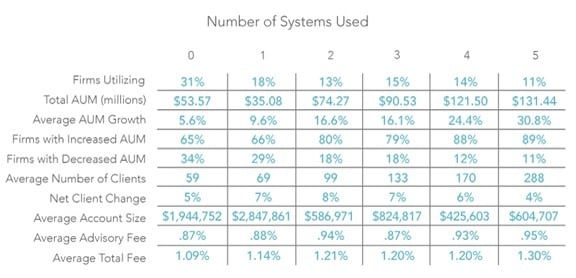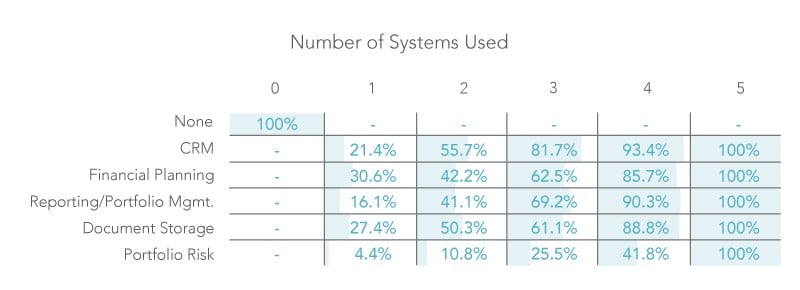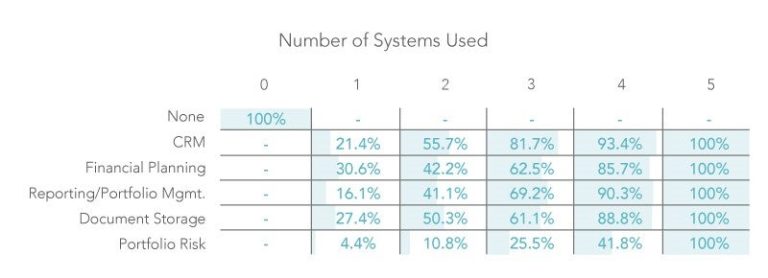The findings in this blog post come from our annual survey of over 1,500 registered investment adviser (“RIA”) firms that was conducted in the first quarter of 2018. This proprietary RIA in a Box study is paired with publicly accessible data provided by the Securities and Exchange Commission (“SEC”). The goal of our annual study is to understand different options that comprise each firm characteristic, and to determine whether specific characteristics affect the growth, size, or operational efficiency of an RIA firm. In this blog post, we are going to focus on technology adoption including the number of systems RIA’s are adopting and the effect that they may have on the firm.
Here we analyzed the same five technology categories from our previous post, An Overview of the Types of Technology Systems Adopted by RIA Firms:
- Customer Relationship Management (“CRM”)
- Financial Planning
- Portfolio Management & Reporting
- Document Storage and Management
- Portfolio Risk Measurement
Over the past several years, our RIA technology studies have consistently revealed that investment in technology has had a positive impact on RIA firm growth and other key metrics. Below are the results from this year’s study looking at the relevant metrics for RIA firms that adopt 0, 1, 2, 3, 4, or all 5 of the the types of technology systems referenced above:

At a high level, it’s not surprising to see that firms adopting a greater number of technology systems tend to be larger firms with higher levels of regulatory assets under management (“AUM”) and total number of clients. While always difficult to attribute causation versus correlation, it’s also quite evident that as firms adopt more technology systems they also appear to experience higher levels of AUM growth and are less likely to experience an annual decline in assets under management. It also is clear that firms with smaller average client account sizes are also more likely to adopt a larger number of technology systems.
As far as how this year’s overall level of technology adoption compares to prior years, we have not seen a significant shift in RIA technology adoption rates:

We believe some of the stagnation in technology adoption rates may be related to the continued growth in the number of new RIA firms being started each year. As we have experienced with our clients, it is rare that a new firm is starting with a full technology stack, comprising of five different systems. In practice, firms tend to build their technology over time, allowing them to grow a technology budget to add additional capabilities. With a steady flow of new firms registering each year, it’s understandable why the numbers are staying fairly stagnant. It’s also possible that some firms see diminishing returns on adopting multiple technology systems, but the growth figures above do seem to show a strong correlation to total AUM growth rate and the total number of systems adopted.
In order for us to better understand the sequence in which RIA firms are adopting technology systems, we created the below matrix to see the relationship between the number of systems adopted by a firm and the types of systems selected:

Firms that only have a single solution tend to start with a financial planning or document storage solution. Once a firm adopts a second type of system, CRM quickly becomes much more widely adopted. Almost all firms that have adopted three systems are using CRM software followed by a mix of financial planning, reporting/ portfolio management, and document storage solutions. It’s not until the fourth or fifth system that firms appear likely to adopt a portfolio risk measurement solution. This is not entirely surprising given that portfolio risk measurement is a relatively newer technology category compared to the four others.
Be sure to check back soon as we continue to explore these five categories of RIA technology systems and continue to release more results from this year’s RIA technology adoption and growth study.
